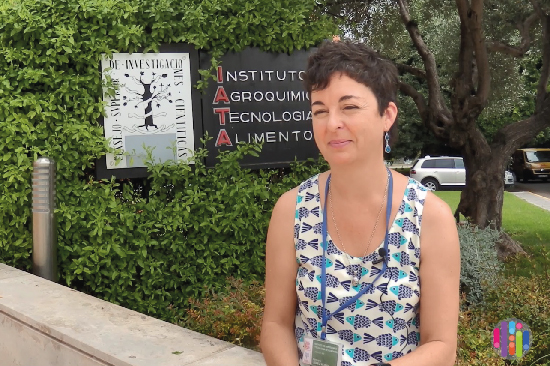
IATA has been gradually resuming its research activity in recent weeks. We have talked to the research staff to find out how they are returning to normal and how this break has affected their research projects.
This week we interviewed Amparo López Rubio.
Amparo López Rubio, researcher at the Institute of Agrochemistry and Food Technology (IATA-CSIC), leads a line of research on nanoencapsulation of bioactive compounds and her research work is focused on understanding the relationship between structure and functionality of ingredients and materials for food use. It also works on the development of new biodegradable and/or biomass-based materials (so-called biopolymers) that are proposed as an alternative to conventional plastics, which they can replace in certain applications.
Among her positions of responsibility, it is worth mentioning her position as current vice-director of IATA, she is Chair of the W&T6 Expert Panel of the FWO (Belgium) since 2019, numerary member of the RSEF and member of the Nanotechnology group of AESAN. Throughout her scientific career she has established numerous national and international collaborations.
Question: How has the confinement time affected the research carried out by your working group? What did you leave behind on the benches?
Answer: A lot of ongoing projects that we are now taking up again. Without a doubt, those that have been most affected have been the doctoral students and, of course, the rest of the projects, although from time to time a break in activity also serves to reflect on the issues at hand and to generate new ideas.
Q: This pandemic caused by SARS-CoV-2 has meant a backward step in the reduction of the use of plastic, something that was gaining ground little by little in society. How can this situation be confronted? What alternative materials do we currently have?
A: It has been a very important setback and a real environmental drama. We have been able to see how, for example, the Costa Azul is flooded with gloves and masks and I am not clear about how this type of plastic waste is being managed. I really believe that certain decisions were taken in this regard, due to the exceptional circumstances, which surely could have been avoided. For example, the use of gloves to enter shops and supermarkets, when simply washing your hands at the entrance and exit would have been a good strategy.
There are now alternatives available to single-use plastics. Clearly not for all the applications we use plastic for today, but single-use alternatives could easily be substituted, but their cost is still higher than that of synthetic plastics, making them difficult to market because in the end money is king.
Q: The circular economy and the use of waste is another key in your research. You are currently coordinating the European project BIOCARB-4-FOOD, which has a budget of one million euros. What are its objectives and what is the current state of research?
A: The BIOCARB-4-FOOD project is focused on the complete recovery of red and brown algae, optimizing on the one hand the obtaining of phycocolloids from these algae (both agars and alginates that are widely used in foods as texturizing ingredients), and on the other hand taking advantage of the residues of these algae after the extraction of the agar or alginate to develop biodegradable packaging films. Right now, we have approximately one year left in the project and the truth is that we have achieved very important advances. On the one hand, we have demonstrated that the use of newer extraction technologies based on ultrasound or enzymatic pre-treatments can increase extraction performance or reduce times, both making these processes more efficient and, on the other hand, we have shown that algae residues can be easily processed into biodegradable materials that could replace synthetic plastics in some food packaging applications.
Q: From next year, the Waste Law will come into effect, banning the use of single-use plastics. In addition to being positive for the planet and society as a whole, will this give a boost to research into alternative materials and what are the new challenges facing your working group?
A: We hope that yes, that there will be more funding in this type of line because they are very necessary. In fact, there are more and more companies interested in the developments we are carrying out in our research group and the challenges we are facing are focused on obtaining materials that are economically viable, simplifying processes and using waste to generate cheap additives that improve the properties of the same. And we expect collaboration with companies so that the results obtained in our laboratories are transferable.

